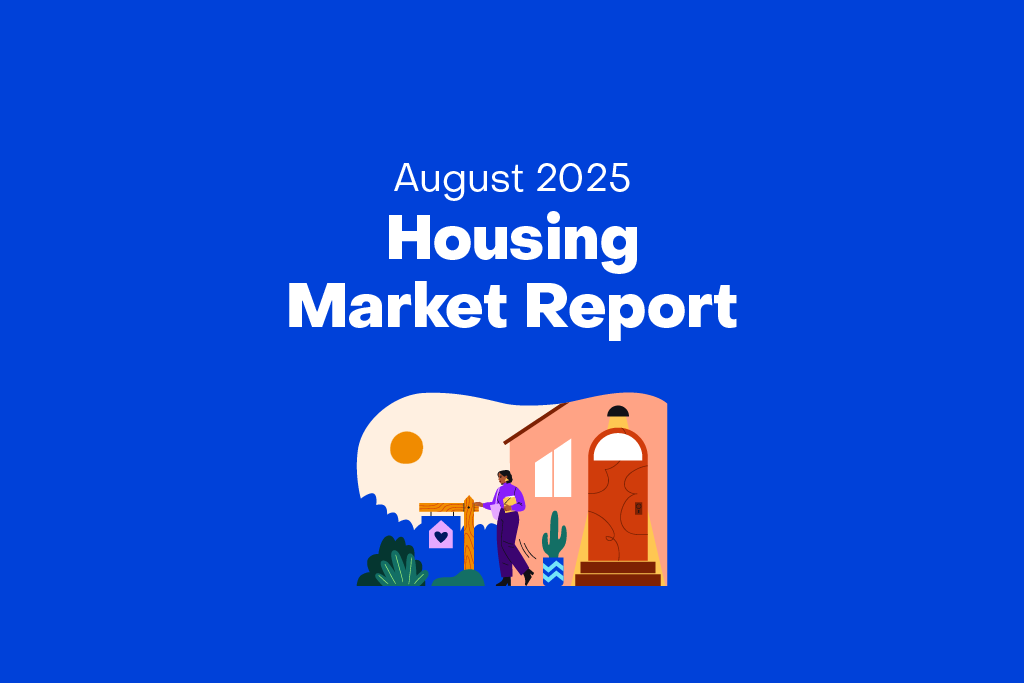Key takeaways:
- Market momentum shifts: Buyers’ recent run of gaining leverage is cut short.
- Price cuts ease from peak: The share of listings with a price cut moderated to 26%, down from the all-time high of 27% in July.
- Inventory high but shrinking: While total for-sale inventory is up 15% year-over-year, it fell month-over-month as the flow of new listings slowed to a trickle.
Sellers took a step back from the housing market in August in response to slow demand from cash-strapped home shoppers. Buyers still in the market have plenty of opportunity, especially in inventory-rich environments. But competitive momentum that has been swinging fast in buyers’ favor in recent months is showing signs of stopping nationwide.
Market dynamics: Sellers respond to cautious buyers
High housing costs continue to sideline prospective buyers, making it easier for those still in the hunt. Zillow’s market heat index shows the market is balanced between buyers and sellers nationwide, with less competition among buyers than in any August since 2018.
As a result, home value appreciation has slowed to a standstill. Typical home value growth nationwide measured by Zillow’s Home Value Index is now flat over the past year — the second-slowest annual growth of any month since the start of 2018.
Homes are lingering longer before finding a buyer as well. The median time on market for a sold home is 27 days — a full week longer than last year and one day longer than pre-pandemic norms. But contrary to seasonal trends, competition ticked back up slightly in August over July from sellers also pulling back.
Homeowners have responded to buyers’ caution by pushing pause on listing plans. New listings from sellers reached a record low for August in Zillow records, and the 7.3% month-over-month drop in new listings is steeper than normal for this time of year.
Potential sellers are probably comfortable with their home for the present, likely enjoying a low mortgage rate and significant equity growth: Typical home values are up 46.5% since before the pandemic.
A weak labor market isn’t pushing a lot of new hires to move either — Zillow’s latest survey of recent sellers found 37% were influenced by a new job. This slowdown in new listing activity caused overall inventory levels to shrink, falling 1.3% from their July peak.
Regional divides: A tale of two markets
National trends mask significant regional differences, where shifts in supply have impacted competition.
- Buyer-friendly markets: Buyers have the most leverage in the South. Former pandemic-era hot spots such as Miami, Tampa, Jacksonville, and Austin now all have more existing options on the market than before the pandemic, thanks in part to builders’ efforts to meet demand. Seattle has made a surprising transition from favoring sellers to buyers over the past year — inventory that’s risen 22% over that time played a key role.
- Seller-friendly markets: The Northeast and the San Francisco Bay Area remain firmly in favor of sellers. Competition is strongest in Buffalo, Hartford, San Francisco, San Jose, and Boston. In these supply-constrained regions, inventory remains far below pre-pandemic averages, keeping the market tilted toward sellers.
Home values
- The typical U.S. home value is $363,946.
- The typical monthly mortgage payment, assuming 20% down, is $1,855.
- Home values climbed month over month in 2 of the 50 largest metro areas in August. Gains were biggest in Buffalo (0.5%), New Orleans (0.3%), Hartford (0%), Chicago (0%), and Birmingham (0%).
- Home values fell, on a monthly basis, in 45 major metro areas. The largest monthly drops were in San Jose (-1.7%), San Francisco (-1.4%), Austin (-0.8%), Seattle (-0.8%), and San Diego (-0.8%).
- Home values are up from year-ago levels in 25 of the 50 largest metro areas. Annual price gains are highest in Cleveland (4.5%), Hartford (4.2%), Detroit (3.6%), Buffalo (3.6%), and Louisville (3.5%).
- Home values are down from year-ago levels in 25 major metro areas. The largest drops were in Tampa (-6.5%), Austin (-5.8%), Miami (-4.9%), Orlando (-4.6%), and Dallas (-3.9%).
- The typical mortgage payment is up 1.1% from last year and has increased by 106% since pre-pandemic.
Inventory and new listings
- New listings decreased by 7.3% month over month in August.
- New listings decreased by 3% this month compared to last year.
- New listings are 22.2% lower than pre-pandemic levels.
- Total inventory (the number of listings active at any time during the month) in August decreased by 1.3% from last month.
- The median age of inventory, the typical time since the initial list date for active for-sale listings, was 66 days.
- There were 15.3% more listings active in August compared to last year.
- Inventory levels are -19.5% lower than pre-pandemic levels for the month.
Price cuts and share sold above list
- 25.8% of listings in August had a price cut. That is down 1.5ppts month over month, and is flat compared to last year.
- 28.8% of homes sold above their list price last month. That is down 2ppts month over month.
- 4.4ppts fewer homes sold above their list price compared to last year.
Newly pending sales
- Newly pending listings decreased by 2.6% in August from the prior month.
- Newly pending listings increased by 4.6% from last year.
- Median days to pending, the typical time since initial list date for homes that went under contract in a month, is at 27 days in August, up 3 days since last month.
- Median days to pending increased by 7 days from last year.
Market heat index
- Zillow’s market heat index shows the nation is currently a neutral market.
- The strongest sellers markets in the country are Buffalo, Hartford, San Francisco, San Jose, and New York.
- The strongest buyers markets in the country are Miami, Austin, New Orleans, Jacksonville, and Tampa.

